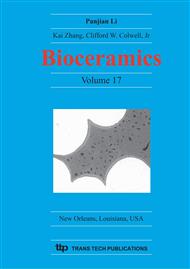p.569
p.573
p.577
p.581
p.585
p.589
p.593
p.597
p.603
Comparison of Validity between WST-1 and MTT Test in Bioceramic Materials
Abstract:
Cytotoxicity test was essential for the pre-clinical evaluation of bioceramics. Proliferation assays such as MTT, XTT and WST-1 were commonly used for measuring biocompatibility. WST-1 was more convenient than MTT because of its water-solubility and storage condition. The calcium phosphate glass and β-TCP have been used for bone substitute, and some magnetic ferrites have been used for hyperthermic treatment. L929, mouse fibroblast cell, was the representative cell-line for in vitro biocompatibility test. The extracts of test samples were prepared by ISO10993-12:2002. The biocompatibilities of the extracts were measured by MTT and WST-1 assay and their pH were measured with pH meter. The cellular survival rate of CPG was the lowest and the results of the WST-1 test showed results similar to those of the MTT test. Thus, proliferation assays using WST-1 may be conveniently and routinely applicable to pre-clinical evaluation of bioceramics.
Info:
Periodical:
Pages:
585-588
Citation:
Online since:
April 2005
Authors:
Keywords:
Price:
Сopyright:
© 2005 Trans Tech Publications Ltd. All Rights Reserved
Share:
Citation:


